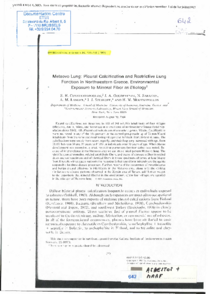Metsovo lung: pleural calcification and restrictive lung function in Northwestern Greece - environmental exposure to mineral fiber as etiology

Constantopoulos, Stavros H. ; Goudevenos, John A. ; Saratzis, Nikolaos ; Langer, Arianna M. ; Selikoff, Irving J. ; Moutsopoulos, Haralampos M.
1985
38
319-331
asbestos ; case study ; environmental pollution ; pleural calcification ; pleural mesothelioma
Asbestos
English
Bibliogr.
"Pleural calcifications are described in 122 of 268 (45.5%) inhabitants of four villages (Metsovo, Anilio, Milea, and Votonosi) in a small area of northwestern Greece (total population about 5000). All affected individuals are of one ethnic group, Vlachi. Calcifications were not noted in any of the 103 persons in the control group made up of 73 non-Vlachi inhabitants from the same and neighboring villages and 30 Vlachi from distant villages. The calcifications were seen in both sexes, equally, and their frequency increased with age, from 28.6% between 30 and 39 years to 81.0% in individuals over 70 years of age. When plaque development was extensive, a small restrictive pulmonary function defect was noted. Because of its prevalence in the Metsovo area we call this clinical pattern Metsovo lung. The identification of tremolite, related amphibole fibers, and traces of chrysotile fiber in settled dusts and soil specimens and of identical fibers in tissue specimens obtained at lung biopsy from 8 people with plaques supports the hypothesis that abestiform minerals are the agents responsible for these disease processes. Further, reports of the occurrence of mesothelioma and benign pleural effusions in inhabitants in the Metsovo area, along with the striking similarities to disease patterns observed in the Karain area of Turkey, add further weight to the hypothesis that mineral fiber(s) in the environment of the four villages are agent(s) in the etiology of Metsovo lung."
Digital
The ETUI is co-funded by the European Union. Views and opinions expressed are however those of the author(s) only and do not necessarily reflect those of the European Union or the ETUI.